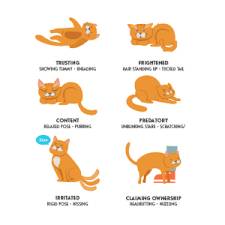Understanding Your Cat’s Body Language: A Guide to Interpreting Feline Behavior
Cats communicate through a variety of body language cues, including facial expressions, ear position, tail movements, and posture. Learning to read these signals can help you better understand your cat’s needs and emotions, and strengthen your bond with them. This guide will provide an overview of some common feline body language cues and what they might mean, including:
Purring
Purring is a common and well-known behavior of cats. It is often associated with contentment and relaxation, but cats may also purr when they are stressed, anxious, or in pain. Purring is thought to be a self-soothing behavior that helps cats regulate their emotions and reduce stress. Cats may also purr as a form of communication, to signal that they are friendly and approachable, or to solicit attention and affection from their human companions. Some cats even purr when they are hungry or want food. Overall, purring is a complex behavior that can have different meanings depending on the context and the individual cat. Paying attention to other signals, such as body language and vocalizations, can help you better understand your cat’s purring and respond to their needs accordingly.
Scratching
Cats scratch for several reasons, including to mark their territory and to keep their claws healthy. Scratching is a natural behavior that is essential for a cat’s physical and mental well-being. When a cat scratches, they leave behind visual and scent cues, which other cats can use to identify their territory. Scratching also helps cats stretch their muscles and maintain healthy claws.
However, scratching can be a frustrating behavior for cat owners, especially when cats scratch furniture or other household items. One effective strategy to redirect this behavior is to provide a scratching post or pad. These items should be made of durable and rough materials, like sisal rope or corrugated cardboard, that cats enjoy scratching. Place the scratching post or pad in an accessible and visible location, and encourage your cat to use it by offering treats or toys nearby.
Another strategy to discourage unwanted scratching is to make the targeted item less appealing to your cat. This can be done by covering the item with double-sided tape or aluminum foil, or by using a citrus-scented spray that cats dislike. It’s also important to avoid punishing your cat for scratching, as this can create fear and anxiety, and may worsen the behavior.
By understanding why cats scratch and providing them with appropriate outlets for this behavior, you can help prevent damage to your furniture and keep your cat healthy and happy. Incorporating this topic into your website’s content can attract cat owners who are seeking advice on how to manage their cat’s scratching behavior.
Hissing
Hissing is a defensive behavior that cats use when they feel threatened or afraid. When a cat hisses, they are warning potential predators or aggressors to stay away. Hissing is often accompanied by other defensive behaviors, such as arched backs, flattened ears, and dilated pupils.
Hissing can be triggered by a variety of situations, such as encountering a new person or animal, feeling cornered or trapped, or being in a high-stress environment. It’s important to respect your cat’s boundaries and avoid forcing them into situations that may make them feel uncomfortable or threatened.
If your cat is hissing, it’s important to approach them calmly and avoid making sudden movements or loud noises. Give your cat space and time to calm down on their own. If the hissing persists or is accompanied by other aggressive behaviors, such as biting or scratching, it may be a sign of a more serious issue, such as fear or anxiety. In these cases, it’s best to consult with a veterinarian or animal behaviorist for advice on how to manage your cat’s behavior.
It’s important to remember that hissing is a normal and natural behavior for cats, and it’s not a sign that they are mean or aggressive. By understanding why cats hiss and how to respond to this behavior, you can help keep your cat safe and comfortable in their environment. Incorporating this topic into your website’s content can attract cat owners who are seeking advice on how to manage their cat’s hissing behavior and strengthen their relationship with their feline friends.
Meowing
Meowing is a common vocalization that cats use to communicate with humans and other cats. Cats may meow for a variety of reasons, including to get attention, express hunger or thirst, indicate pain or discomfort, or seek affection. Some cats are more vocal than others, and the frequency and intensity of their meowing can vary depending on their age, breed, and personality.
When your cat meows, it’s important to pay attention to the context of their vocalization. For example, if your cat is meowing more frequently than usual, it may be a sign that they are feeling stressed or anxious, or that they are in pain. If your cat is meowing for food, it’s important to ensure that they are being fed a balanced and nutritious diet, and that they are not overeating or under-eating.
In some cases, excessive meowing can be a sign of an underlying health issue, such as hyperthyroidism or cognitive dysfunction. If your cat’s meowing behavior suddenly changes or becomes more intense, it’s important to consult with a veterinarian to rule out any medical problems.
It's Important to respond to your cat’s meowing in a calm and consistent manner. Avoid punishing or shouting at your cat, as this can create fear and anxiety and may worsen their behavior. Instead, try to understand what your cat is trying to communicate and respond to their needs accordingly. Providing your cat with plenty of attention, playtime, and affection can also help reduce excessive meowing.
By understanding why cats meow and how to respond to this behavior, you can improve your relationship with your feline friend and provide them with the care they need. Incorporating this topic into your website’s content can attract cat owners who are seeking advice on how to manage their cat’s meowing behavior and improve their overall well-being.
Licking
Licking is a natural behavior that cats use to groom themselves and others. When cats lick themselves, they are removing dirt and debris from their fur and keeping their skin and coat clean and healthy. When cats lick other cats or humans, it can be a sign of affection and bonding.
However, excessive licking can be a sign of an underlying health or behavioral issue. Cats may over-groom themselves due to stress, anxiety, or boredom, which can lead to hair loss and skin irritation. Cats may also lick excessively due to medical conditions, such as allergies or pain. If your cat is licking excessively, it’s important to consult with a veterinarian to rule out any underlying medical problems. If medical issues are ruled out, it’s important to consider environmental factors that may be contributing to your cat’s behavior. Providing your cat with plenty of mental and physical stimulation, such as toys and playtime, can help reduce stress and boredom. Creating a calm and predictable environment can also help reduce anxiety and promote relaxation.
It's also Important to provide your cat with appropriate outlets for grooming and licking behavior. Providing a scratching post or pad can help redirect excessive licking away from their fur and onto a more appropriate surface. Providing your cat with grooming brushes or combs can also help promote healthy grooming behaviors.
By understanding why cats lick and how to respond to excessive licking behavior, you can help keep your cat healthy and happy. Incorporating this topic into your website’s content can attract cat owners who are seeking advice on how to manage their cat’s licking behavior and improve their overall well-being.
Understanding cat behavior is crucial to providing the best care and companionship for your feline friend. From purring to meowing, scratching to licking, cats use a wide range of behaviors to communicate their needs and emotions. By learning to interpret and respond to these behaviors, you can build a stronger bond with your cat and provide them with the care and attention they need to thrive.
It's important to remember that every cat is unique, and may exhibit different behaviors depending on their age, breed, and personality. By observing your cat's behavior and consulting with a veterinarian or animal behaviorist as needed, you can provide your cat with customized care that meets their individual needs.
Incorporating topics related to cat behavior into your website’s content can attract cat owners who are seeking advice on how to better understand and care for their furry friends. By providing informative and helpful content, you can build a loyal audience and establish yourself as a trusted authority in the world of cat care.


